Bird race becomes learning opportunity
Event around Qinghai Lake showcases biodiversity and conservation efforts

On the afternoon of May 27, in a meeting room at a hotel in Gangca county, Qinghai province, Lei Jinyu was preparing a Power-Point presentation on his laptop, feeling a bit nervous.
As the secretary-general of the Rosefinch Center, a nonprofit organization dedicated to promoting bird-watching and bird conservation, Lei had given numerous speeches about his work and passion. "But I'd never done it for an audience of Tibetan herders," he told China Daily. "I was not sure if they would fully understand my Mandarin. Maybe I needed to use simpler words?"
However, once all the participants arrived, Lei realized he had worried too much and felt relieved. Although his listeners were Tibetan, most of them were not herders but female tour guides from two of the county's scenic areas, all fluent in Mandarin. Only two male participants were actually herders, but they had no difficulty understanding his words.
Over the next hour and a half, Lei introduced his audience to bird-watching, including its history, its growing popularity in China, and details about dozens of common birds found around Qinghai Lake — the country's largest lake — located near Gangca.
"I finally know the Mandarin names of some birds I am quite familiar with, such as heijing he (black-necked crane), bantou yan (bar-headed goose) and gaoshan wujiu (Himalayan vulture)," said Sebon Gya, a 32-year-old herder from Yehormao village and a part-time patrolman in the village on the northern bank of the lake.
Sebon Gya, whose primary responsibility is identifying potential threats to the village's grasslands, such as fire hazards or damaged fencing, also monitors wildlife around the village. "Rabbits and pikas (small egg-shaped mammals) are common, and wolves and foxes appear from time to time," he said. "Now I understand that Qinghai Lake is an important habitat for many water birds."
Tsesang Je, 23, has been working with the Hargai Town Przewalski's Gazelle Science Education Base in the county for just under a year. While her main job is guiding tourists to observe Przewalski's gazelles, an endangered species under the State's first-level protection, she occasionally faces questions about the area's birds.
"After the lecture, I can provide better answers to our customers," she said.
"Many water birds live in the grasslands near our base. I will suggest to our managers that we add more content about the birds to our guided tours."
The lecture was actually a side program for a bird-watching and educational event, "Beautiful Qinghai, Bird-watching at the Great Lake". Held from May 25 to 29 around Qinghai Lake, the event was organized by the Qinghai Lake Scenic Area Protection and Management Administration and the Qinghai Provincial Forestry and Grassland Bureau, with co-organizers including the Qinghai Lake National Nature Reserve Administration and the China Bird Watching Organizations' Joint Action Platform (Rosefinch Center).
A different bird race
"The side program demonstrated the uniqueness of our event," said Zhong Jia, one of the founders of the center and also of the country's first group of bird-watchers. Many of the country's bird-watching events in the past 10 years, especially bird races, have been the brainchild of the 72-year-old retired newspaper editor and former environmental reporters.
Bird races are events where participants "race" to identify bird species within a specific area and timeframe. The participant or team that identifies the most species is declared the winner.
"This event was actually a bird race, but the local organizers asked us to put our emphasis on education," she said. "So it was also a public education campaign."
At the launch of the event in Gangca, Chen Dehui, deputy director of the Qinghai Lake Scenic Area Protection and Management Administration, said that Qinghai Lake is a typical representative of the plateau lake wetland ecosystem.
It is an important body of water as the ecological security barrier of the Qinghai-Tibet Plateau and a crucial habitat for rare and endemic species in the cold and arid plateau region.
Qinghai Lake's wetland ecological environment and wildlife habitats have continuously improved over the years through dedicated efforts, he said.
The overall ecological function of Qinghai Lake has been steadily enhanced, with more than 3,400 Przewalski's gazelles galloping along its shores, 600,000 water birds breeding in the wetlands and 127,500 metric tons of naked carp (Gymnocypris przewalskii) migrating between the lake and upstream rivers.
"The purpose of conducting the bird science education activity is to let more people appreciate the unique charm of these featured friends and recognize the importance of bird conservation for maintaining biodiversity and strengthening the ecological security barrier," he said.
At present, he said, the establishment of Qinghai Lake National Park is at a critical stage. The creation of a national park involves not only protecting the clear waters and vast grasslands of Qinghai Lake but also safeguarding its rich biological resources and unique ecosystem.
"The event is an essential part of the national park's establishment efforts," he said. "Through such kind of activities, we aim to further enrich the results of bird monitoring, build social consensus and spread the concept of national parks. The ultimate goal is to establish Qinghai Lake as a national park and an international eco-tourism destination."
Fifteen teams, comprising 60 bird enthusiasts from 21 provinces, municipalities and autonomous regions across China — including front-line rangers from various nature reserves — participated in the event. Over a span of 77 hours, they engaged in intensive bird observation activities around Qinghai Lake, covering the counties of Haiyan, Gangca and Gonghe.
"The road circling Qinghai Lake spans about 360 kilometers," Zhong explained. To reach certain birding sites by the lake, the bird-watchers often had to navigate bumpy dirt roads and find their way through broad grasslands, which Zhong described as "a maze created by fencing".
To complete the race in three days, all participants had to lodge in a different hotel each night. Two of these hotels were located on the northern bank of the lake, while another was on the southern bank. "To visit the best birding sites multiple times, we often had to drive back and forth, spending long hours in the car," Zhong said. "I think to complete the race, a team would probably drive more than 1,000 km."
During the event, the bird-watchers — equipped with cameras featuring telephoto lenses and telescopes on tripods — became a part of the landscape along the broad and open lake shore. "The bird-watching, much like a form of performing art, highlighted the importance of Qinghai Lake as a bird sanctuary to local herders and other tourists," Lei said.
Quite an experience
For many participants, the primary motivation for attending the event was likely not education or even competition, but rather the thrill of bird-watching and the pursuit of new records for themselves, if possible, and for the nature reserve and the province.
Yang Zhidong, a participant from Shanghai, embodies this passion. An avid birdwatcher for over 20 years, the retired school teacher has visited Qinghai three times for bird-watching. "I previously watched birds on the southern bank of Qinghai Lake," he said. "This is my first time birding around the entire lake. During the race, we drove just shy of 1,200 km. On our longest day, we spent 14 hours birding in the wild."
The efforts of Yang and his teammates paid off. He spotted the red-necked grebe, a rare water bird, marking a "lifer" — a birdwatching term for a first-time sighting. Besides, they photographed the chestnut-bellied rock thrush, setting a new record for the nature reserve.
Xia Yong, a bird-watcher from the Xinjiang Uygur autonomous region, experienced a thrilling, roller coaster-like adventure during the race. The retiree, accompanied by a birding friend from Xinjiang, teamed up with two other bird-watchers for the event.
"Many birds here are similar to those found in Xinjiang," she said. "So I didn't expect to see many lifers here. But my friend and I had never bird-watched in Qinghai before. We just wanted to enjoy the race."
Perhaps too engrossed in the excitement, her friend lost her footing while trying to climb over a fence at a birding site on the second day of the race. She fell to the ground and was later diagnosed with a fractured sternum at a hospital in Gangca. She had to withdraw from the race and wait in the hospital until Xia completed the event. Together, they would take an ambulance to Xining, the provincial capital, and then board a train back to Xinjiang.
"On May 26, I helped arrange her treatment until 10 pm," Xia said. "It was truly a long day for me."
Despite the setback, she returned to the race with her other teammates the next day and experienced a highlight moment on May 28. A team found a female cotton pygmy goose at a wetland on the eastern bank of Qinghai Lake and shared the sighting with other teams. As a result, three teams, including Xia's, arrived at the site later.
The water surface was vast, and hundreds of ducks, grebes and geese floated on it. Searching for a single bird through telescopes was a time-consuming and challenging task. "When we arrived, a team had failed to find the goose and decided to give up," Xia said. "We scanned the lake again and again. When one of us finally called out, having found the bird, I felt so excited and relieved."
The goose, an extremely rare bird in Qinghai Lake, marked a lifer for Xia.
On the morning of May 29, a results-sharing event was held in Xining, where awards were presented to the participating teams.
A total of 175 bird species were recorded during the event, including six species under national first-level protection and 23 species under national second-level protection.
Professor Chen Zhenning from Qinghai Normal University highlighted that the bird species list compiled during the event essentially encompassed most of the bird species observable in the Qinghai Lake reserve this season.
Notably, the list included at least three new records for the nature reserve, marking a significant achievement. One highlight was the Asian desert warbler, observed and photographed by one of the teams. This species is a new record for the province and was chosen as the top bird of the event.
Wang Jianting, head of the Qinghai National Park Bird-watching Society, has participated in a few bird surveys around the lake over the years and is familiar with birds distributed in the area.
"Our traditional surveys usually focused on water birds living around the lake and sometimes neglected such habitats as small patches of woods or sparse scrubs, which produced many surprises for us this time," he said. "So the event has truly broadened our understanding and vision of the avian life around Qinghai Lake."
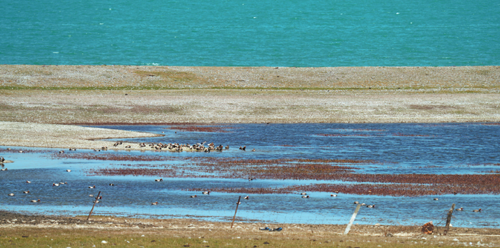
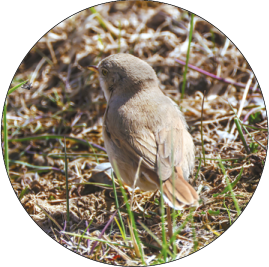
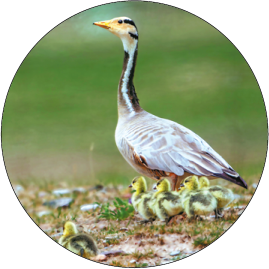
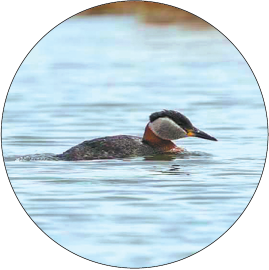
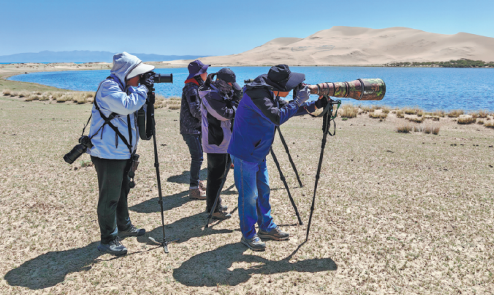

Today's Top News
- Israel launches attack on Iran's nuclear sites
- Israel conducts preemptive strike on Iran
- The bumpy road of international trade
- China, Africa pledge to strengthen trade ties
- Li: Bolster Sino-EU cooperation
- Carmakers vow to ensure timely payments for suppliers






























